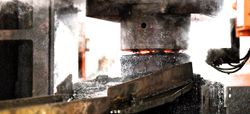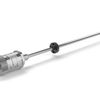Magnetostrictives position sensor in hot forging press
How to monitor and control your hot forging press with the WRA-A magnetostrictive position sensor and the KS pressure position sensor
Hot forging press is compressing billets and ingots of iron or steel at very high temperatures
The hot forging press, used for machining metals such as iron and steel, requires sensors with a high degree of resistance to shocks and vibrations to maintain the repeatability of the position measurement and the safety of the closed circuit hydraulic circuit.
A hot forging press must compress billets and iron or steel ingots with very high temperatures. Only in this way the forging press can compact and change their final shape by using presses with hydraulic drive.
WRA-A magnetostrictive position transducers and KS pressure position sensor can guarantee a high degree of repeatability and control of the closed circuit pressure of the hydraulic circuit.
Overview
- High resolution WRA-A Magnetostrictive position transducer – 900 mm stroke – inside cylinder mounting
- SIL 2 KS pressure transducer to provide measurement of the oil pressure of the hydraulic circuit
- Hot forging press requiring sensors with high degree of resistance to shocks and vibrations, to maintain the repeatability of the position measurement and the safety of the closed-circuit hydraulic circuit
The process
Forging is a metalworking process, it can be done with presses powered by hydraulics. Some metals may be forged cold, but iron and steel are almost always hot forged. In the case of hot forging, a high-temperature furnace is required to heat ingots or billets.
The scope of a hot forging press is to compress iron or steel billets and ingots at very high temperature to compact and changing their final shape.
The forging press process is controlled in a closed circuit, allowing the movement of two or more hydraulic cylinders, to which the forge ram that compresses the metal is connected. For high tonnage applications, the ram is repositioned using return cylinders.
In some cases the workpiece is moved by a gripper and the lower base plate can be adjusted horizontally. In both cases the controls are hydraulic.
The challenge
- Process requiring a very high degree of repeatability of the position measurement considering the high intensity shocks and vibrations.
- The pressure transducer needs to be certified to support SIL2 safety integrity for oil circuit.
- The billets and ingots are forged between 950–1250 °C, as a consequence the working temperature on board and around the forging press is quite high. For this reason, the electronic equipment mounted on board of the press must be very robust and be able to work under harsh environment.
Products benefits
- The WRA-A Magnetostrictive position transducers, with a resolution of 16 bits (65536 divisions) and a linearity error ≤ ±0,01%, ensure a high degree of repeatability.
- It can withstand shocks with accelerations up to 100g, vibrations up to 15 g and a working temperature from -30 up to 85°C.
- The KS pressure transducer, with the Safety Integrity Level 2 (SIL2) certification, ensures that the pressure control of the closed loop of the hydraulic circuit is carried out according to high safety standards.
Solution
Position control of the punch of the hot forging press:
WRA-A Transducers Rod: inside the cylinders – 2 nos.
- Transducer stroke: 900 mm, rod in AISI 316
- Working pressure: 250 bar
- Signal linearity (error): ≤ ±0,01% FS
- Shock Resistance: 100 g
- Vibrations Resistance: 15 g
- Working Temperature: -30… + 85 °C
Oil pressure measurement of the hydraulic circuit:
KS pressure transducer – 1 no.
- Safety Integrity Level 2 (SIL 2) certified





